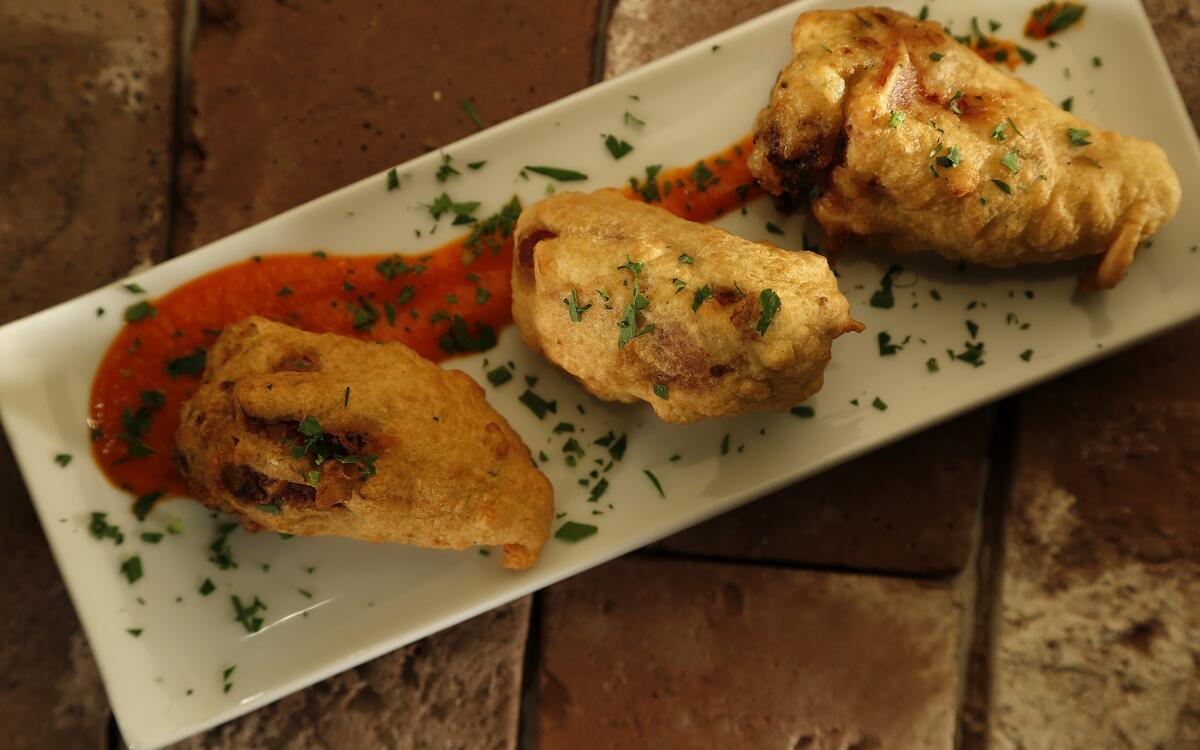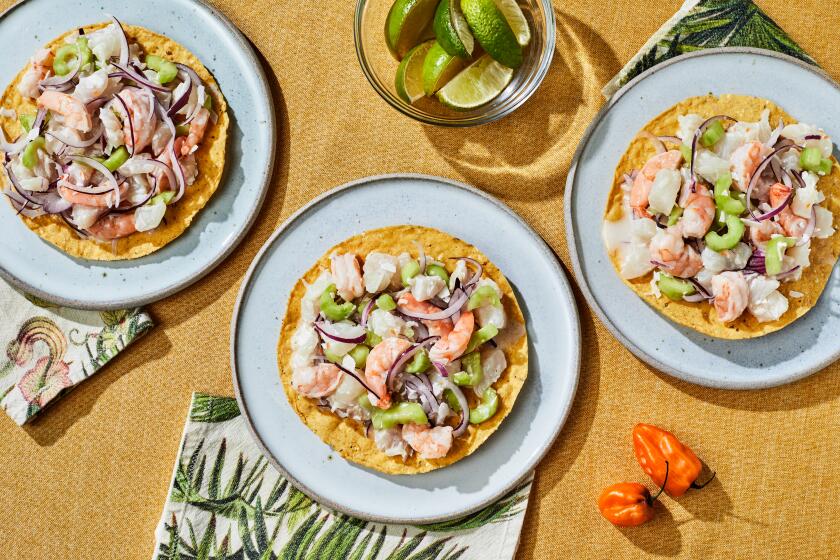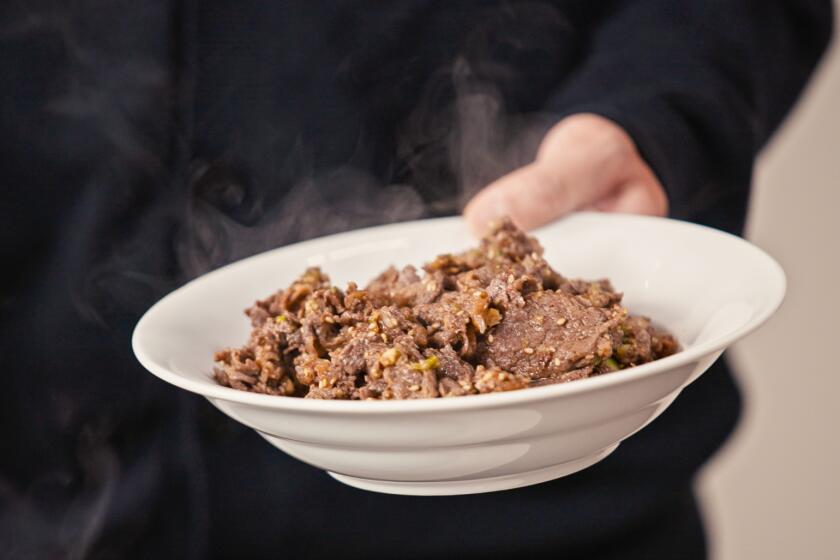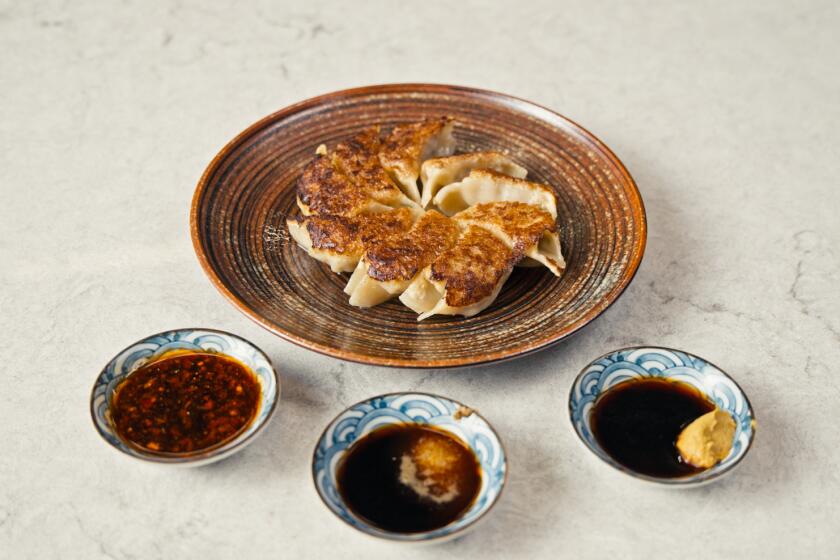Stuffed peppers

— “I’ll only be a minute,” says Juan Muga of Bodegas Muga as he heads off to a whitewashed building next to a vineyard. I walk along the vineyard, taking in the idyllic view of Tempranillo vines stretching across the Ebro river valley, framed by the Sierra Cantabria and Demanda mountain ranges in Spain. Just days before the harvest in October, blue skies, big vistas and bees, dive-bombing wildflowers between the vines.
Smelling smoke, I turn to see that Muga, U.S. marketing director for his family’s estate, has rolled out a grill and set grapevine cuttings alight. A folding table holds a rosé, wineglasses and a bright orange coil of fresh chorizo. Once the flames die down, he pricks the sausage with a fork and lays it on the grill. Ash swirls around us like snowflakes. “For chorizo and lamb chops,” he tells me, “sarmiento (vine cuttings) is the best.”
He cuts the quickly cooked sausage into lengths and slips them between halves of crusty bread. We eat the impromptu sandwich standing, washed down with the dry rosé, a perfect late-morning snack. The taste of that fat-marbled, paprika-streaked sausage washed down with that crisp rosado is now firmly lodged in my memory bank.
Riojan cuisine is direct and simple, based on the great products grown in the Ebro river valley. We Angelenos tend to mix any wine with any cuisine, but this is a lesson in how well the cuisine and wines of a single region mesh to create a seamless, serendipitous experience.
As we sit down to lunch in a small dining room furnished with old black-and-white photographs of the family, Muga mentions that his grandmother, who was a formidable taster, founded the winery. Today the third generation — her four male grandchildren — are in charge.
We began with fat white asparagus the family puts up in season. Quite the delicacy, each tender spear is cloaked in the lightest vinaigrette. With it, we drink the 2012 Muga Blanco, a cask-fermented white made from the Viura grape. Palest gold, it is fragrant, ripe, a little tropical, its flavors dancing with the subtle earthiness of the asparagus.
Most of the recipes are his grandmother Aurora’s. She was a terrific cook, says Muga, but this next dish is his father’s: sliced juicy red tomatoes stacked in alternating layers with jamon iberico. It is simple, and great with the Blanco, its ripeness a contrast to the tomato’s acidity and the salty richness of the ham.
Next up, his grandmother’s piquillo peppers stuffed with beef and pork in béchamel sauce and served with a scarlet pepper sauce so bright it’s almost fluorescent. The wine is the 2009 Reserva, a blend of Tempranillo with Garnacha and some Mazuelo and Graciano. Smoky on the nose, it is soft and alluring, ready to drink now. And it works beautifully with the peppers’ deep flavors.
My favorite dish is a rustic bean soup cooked with chorizo and pork riblets. The velvety pochas beans bob in a rich broth embellished with pimento-streaked chorizo. We eat the soup with vinegary hot green pickled peppers called guindillas. For this, the Reserva makes a good match, but the 2009 Selección Especial, much darker in tone and more complex, is even better.
Spain has some of the best lamb in the world. And here it comes, a platter of baby lamb chops grilled over vine cuttings. “No knife and fork. By your hands,” he instructs, eating them with relish, for probably the fifth time this week. Served with strips of roasted peppers, the lamb is succulent and sweet, perfect with the silky, voluptuous 2005 Prado Enea “Gran Reserva.” The superb Rioja rings deep and true, each sip melding its dark fruit with the baby lamb. One of the great food and wine matches.
Dessert is light: pears cooked in young Rioja. And to finish: Muga mixes us a gin and tonic. His is made with Fever-Tree tonic and Master’s Dry Gin from London. “Any time, even if it’s cold, we drink gin and tonic.” Even this most sophisticated Spanish taster has his quirks.
Sauce
In a sauté pan, heat the olive oil over medium heat. Add the onion and sweat, stirring occasionally, until the onion is softened and translucent, 6 to 8 minutes.
Stir in the piquillo peppers, along with the water. Increase the heat to medium high and bring to a gentle simmer.
Taste the sauce, adding one-half teaspoon of sugar, or as desired, to sweeten slightly, along with three-fourths teaspoon salt, or to taste.
Remove the sauce to a blender and purée until smooth; strain the sauce if desired. Return the sauce to the sauté pan and gently simmer for 10 minutes to marry the flavors. Thin if desired with additional water, and taste and adjust the sugar and salt again as needed. This makes about 2 cups sauce.
Make the bechamel sauce: In a medium saucepan, heat the oil over medium heat. Whisk in the flour to form a roux. Slowly add the milk, whisking to make sure the flour does not clump. Bring the mixture to a gentle simmer, whisking frequently. Cook uncovered for 20 minutes, stirring frequently (be sure to scrape the bottom of the pan to prevent the flour from settling and burning). Taste the mixture, seasoning with salt and adding one-eighth teaspoon ground nutmeg, or as desired, for flavor. Strain the sauce, discarding any solids. This makes about 11/4 cups bechamel; the bechamel will continue to thicken as it cools while the meat is cooked.
In a sauté pan, heat the olive oil over medium-high heat. Add the onion and cook until translucent, 4 to 6 minutes, then stir in the garlic and cook until aromatic, about 1 minute. Stir in the ground pork and beef, and cook until browned, about 10 minutes. Stir in the parsley, then taste and season with 11/4 teaspoons salt and one-fourth teaspoon pepper, or as desired. Remove from heat and drain the meat, discarding the fat. Set aside to cool.
In a large bowl, combine the meat with one-half cup bechamel and the bread crumbs, stirring or kneading to form a cohesive filling (if the filling is too crumbly, add bechamel as needed). This makes a generous 3 cups filling.
Prepare to deep-fry: Fill a medium, heavy-bottomed stock pot with enough oil to come up the sides by at least 3 inches, and heat the oil to 350 degrees.
Stuff each pepper with 1 to 2 tablespoons filling, depending on the size of each pepper. Dip the stuffed peppers in the egg batter and fry until the crust is a light golden brown. Remove and drain the peppers on paper towels, then serve the hot peppers, garnished with chopped parsley and with the sauce on the side.
Get our Cooking newsletter.
Your roundup of inspiring recipes and kitchen tricks.
You may occasionally receive promotional content from the Los Angeles Times.















